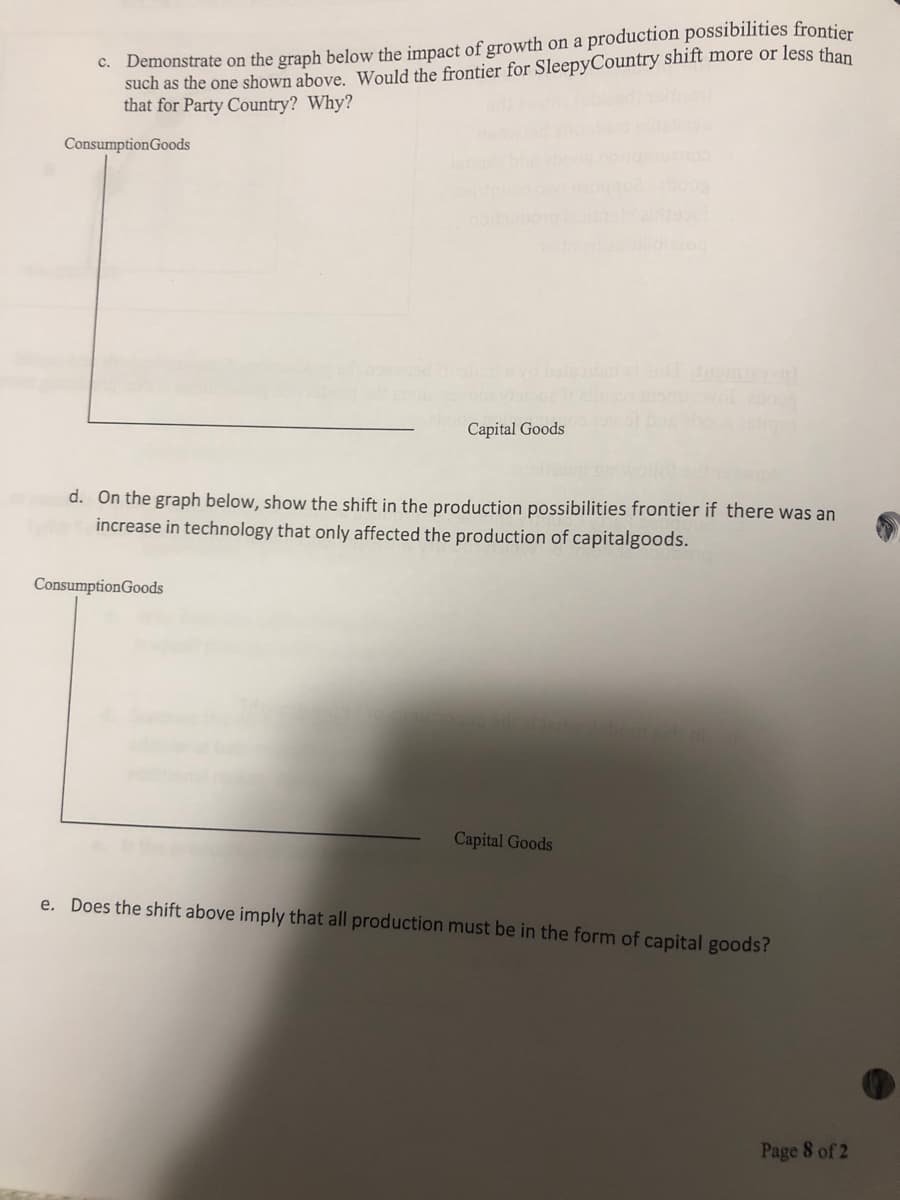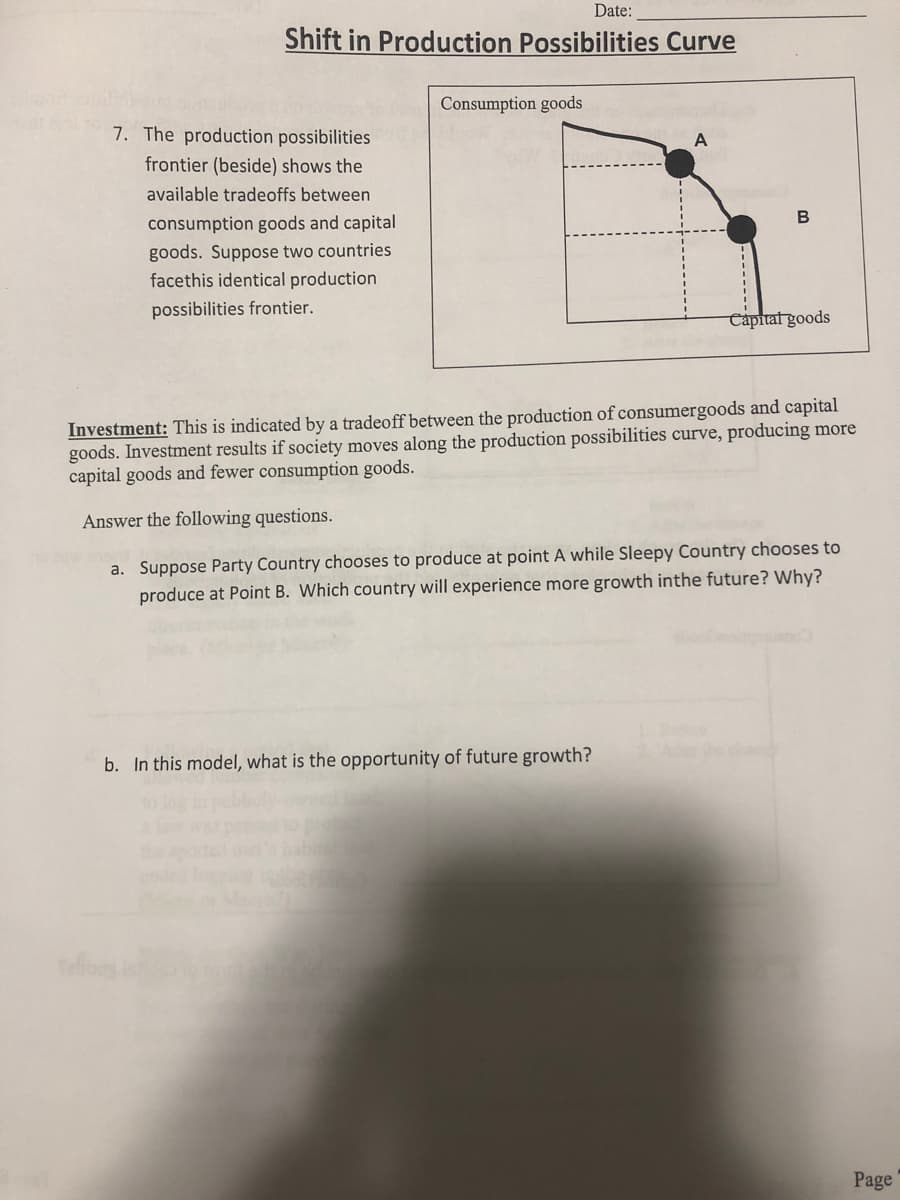Consumption goods 7. The production possibilities A frontier (beside) shows the available tradeoffs between consumption goods and capital goods. Suppose two countries facethis identical production possibilities frontier. Capital goods Investment: This is indicated by a tradeoff between the production of consumergoods and capital goods. Investment results if society moves along the production possibilities curve, producing more capital goods and fewer consumption goods. Answer the following questions. a. Suppose Party Country chooses to produce at point A while Sleepy Country chooses to produce at Point B. Which country will experience more growth inthe future? Why? b. In this model, what is the opportunity of future growth?
Consumption goods 7. The production possibilities A frontier (beside) shows the available tradeoffs between consumption goods and capital goods. Suppose two countries facethis identical production possibilities frontier. Capital goods Investment: This is indicated by a tradeoff between the production of consumergoods and capital goods. Investment results if society moves along the production possibilities curve, producing more capital goods and fewer consumption goods. Answer the following questions. a. Suppose Party Country chooses to produce at point A while Sleepy Country chooses to produce at Point B. Which country will experience more growth inthe future? Why? b. In this model, what is the opportunity of future growth?
Principles of Economics 2e
2nd Edition
ISBN:9781947172364
Author:Steven A. Greenlaw; David Shapiro
Publisher:Steven A. Greenlaw; David Shapiro
Chapter2: Choice In A World Of Scarcity
Section: Chapter Questions
Problem 22CTQ: What assumptions about the economy must he true for the invisible hand to work? To what extent are...
Related questions
Question

Transcribed Image Text:c. Demonstrate on the graph below the impact of growth on a production possibilities frontier
such as the one shown above. Would the frontier for SleepyCountry shift more or less than
that for Party Country? Why?
ConsumptionGoods
Capital Goods
d. On the graph below, show the shift in the production possibilities frontier if there was an
increase in technology that only affected the production of capitalgoods.
ConsumptionGoods
Capital Goods
e. Does the shift above imply that all production must be in the form of capital goods?
Page 8 of 2

Transcribed Image Text:Date:
Shift in Production Possibilities Curve
Consumption goods
7. The production possibilities
frontier (beside) shows the
available tradeoffs between
consumption goods and capital
goods. Suppose two countries
facethis identical production
possibilities frontier.
Cápital goods
Investment: This is indicated by a tradeoff between the production of consumergoods and capital
goods. Investment results if society moves along the production possibilities curve, producing more
capital goods and fewer consumption goods.
Answer the following questions.
a. Suppose Party Country chooses to produce at point A while Sleepy Country chooses to
produce at Point B. Which country will experience more growth inthe future? Why?
b. In this model, what is the opportunity of future growth?
Page
Expert Solution
This question has been solved!
Explore an expertly crafted, step-by-step solution for a thorough understanding of key concepts.
This is a popular solution!
Trending now
This is a popular solution!
Step by step
Solved in 4 steps with 2 images

Recommended textbooks for you

Principles of Economics 2e
Economics
ISBN:
9781947172364
Author:
Steven A. Greenlaw; David Shapiro
Publisher:
OpenStax

Principles of Economics 2e
Economics
ISBN:
9781947172364
Author:
Steven A. Greenlaw; David Shapiro
Publisher:
OpenStax